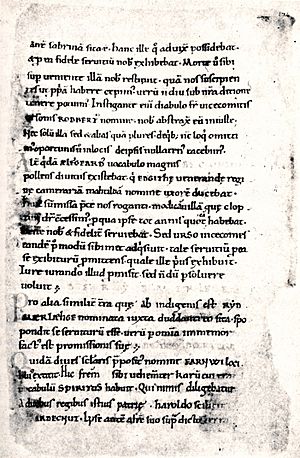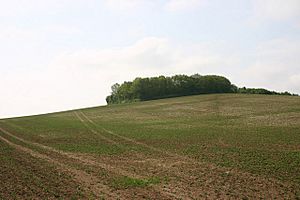Eadric Streona facts for kids
Eadric Streona was an important English leader during a tough time in history. He was the Ealdorman of Mercia (a powerful regional ruler) from 1007 until King Cnut had him killed in 1017. Eadric got his nickname "Streona," which means "The Acquisitive" or "The Grasper," because he was known for taking church land and money for himself. He became famous in the Middle Ages for his actions during the Danish takeover of England.
Eadric came from a fairly normal family; his father was not a very important noble. Even before becoming an ealdorman, Eadric seemed to help King Æthelred the Unready enforce his will. For example, in 1006, he was involved in the killing of Elfhelm, the Ealdorman of York. By 1009, Eadric married Æthelred's daughter, Eadgyth, becoming the king's son-in-law. He was appointed Ealdorman of Mercia in 1007.
As an ealdorman, Eadric played a big role in the kingdom's events. In 1009, he tried to make a deal with Vikings to save Archbishop Ælfheah of Canterbury, but it didn't work. Eadric also continued to arrange for the deaths of other important nobles, supposedly on the king's orders. However, in 1015, he switched sides and joined the Dane Cnut, who was the son of Sweyn Forkbeard, against England.
Eadric joined Cnut in raiding England. In the summer of 1016, Cnut fought a series of major battles with Edmund Ironside, who became king after Æthelred died. The most important battle was at Assandun on October 18, 1016. By this time, Eadric had rejoined King Edmund's side. However, he left the battlefield with his men for reasons that are not clear, though it might have been planned. After Cnut and Edmund made peace, Eadric was allowed to keep his title. But about a year later, Cnut had Eadric killed in London during the Christmas celebrations in 1017.
Template:TOC limit=3
Contents
What's in a Name?
Eadric's nickname "Streona" means "The Acquisitive" or "The Grasper." This name first appeared in a historical book called Hemming's Cartulary. It suggests he was someone who liked to gain a lot for himself.
Eadric's Early Life
Family Background
Eadric's family seemed to have connections in Shropshire and Herefordshire. A historian named John of Worcester wrote that Eadric's father was Æthelric, a noble who attended the king's court. Eadric had several brothers and sisters, including Brihtric, Ælfric, Goda, Æthelwine, Æthelweard, and Æthelmær. These family members often appeared together in official documents, suggesting they were a close-knit group.
Before 1009, Eadric married Eadgyth (also known as Edith), who was the daughter of King Æthelred. This marriage was likely a political move to make alliances stronger. Even though Eadric served King Æthelred for many years, he ended up changing his loyalty several times and betraying his wife's family. There are no records of Eadric and Eadgyth having children together.
Starting His Career
Eadric first appears in historical records around 1002, along with his father and brother Brihtric. Other members of his family were also present at the king's court around 1004–1005. In 1006, Eadric was involved in the death of Ealdorman Ælfhelm. A historical account says that Eadric invited Ælfhelm to a feast in Shrewsbury. During the feast, Eadric arranged for a butcher named Godwine Porthund to kill Ælfhelm while they were hunting. Soon after, Ælfhelm's sons were blinded on King Æthelred’s orders.
In 1007, Eadric was appointed Ealdorman of Mercia. It was around this time, or perhaps a bit earlier, that he married King Æthelred's daughter, Eadgyth. This marriage likely helped him rise quickly to a position of power.
Ealdorman of Mercia
Dealing with Vikings
Eadric became the Ealdorman of Mercia in 1007. This important position had been empty since 985. Eadric seemed to have a good relationship with King Æthelred, especially since he married the king's daughter.
Around this time, King Æthelred ordered a new fleet of warships to be built. However, this effort was weakened when a man named Wulfgeat, accused of treason by Eadric's brother, became a pirate. This made England more open to attacks from the sea. In 1009, an army led by Thorkell the Tall arrived and caused a lot of damage across the country. King Æthelred wanted to fight back, but Eadric advised him not to. This hesitation led to two more years of conflict. The fighting finally ended when Eadric, who was in London, oversaw a large payment of £48,000 to the Danes in 1012. During these talks, they also tried to free Archbishop Ælfheah of Canterbury, but he refused to be ransomed and was killed by his captors. In the same year, Eadric also raided St David's in Wales.
Danish Invasion
In 1013, Sweyn Forkbeard came to England, planning to become its king. By the end of that year, English resistance had fallen apart, and Sweyn had conquered the country. Eadric's exact role during this time is not clear. Some records suggest he went across the English Channel to Normandy with Queen Emma and many soldiers. King Æthelred followed them in January 1014.
However, the situation changed suddenly when Sweyn died on February 3, 1014. The Danish sailors who had supported Sweyn immediately pledged their loyalty to his son, Cnut. But leading English nobles sent a message to King Æthelred, asking him to return to the throne. They asked him to declare his loyalty to them, make reforms, and forgive past actions against him. Æthelred soon regained his throne with help from Olaf Haraldsson. Cnut went back to Denmark, and his allies were punished.
In 1015, a meeting was held in Oxford. Eadric invited two nobles, Sigeferth and Morcar, from the East Midlands. Sadly for them, Eadric had them killed, possibly because they had worked with the Danes. This allowed Prince Edmund to take their lands.
Danes Return to England
Cnut returned from Denmark in August 1015 with a large invasion force. He immediately began raiding in Dorset, Wiltshire, and Somerset. Eadric gathered an army, and Prince Edmund joined him. It is believed that Eadric intended to betray Edmund, but he couldn't when their forces met. The armies separated without fighting, and Eadric soon took forty ships from the royal fleet, fled to Cnut, and joined his service.
Around the New Year, Eadric went with Cnut into Warwickshire, where they raided and burned everything. Prince Edmund gathered an army to face them, but his Mercian forces refused to fight the Danes and broke apart. Edmund then assembled another army and, with help from Earl Uhtred of Northumbria, raided Eadric's lands. Uhtred returned to his home to submit to Cnut, but he was killed and replaced by Eric Haakonsson.
King Æthelred died on April 23 in London. His son Edmund was chosen as king of what was left of his father's kingdom. But Edmund had little time. The Danish army went south to London. Edmund left for Wessex, and Eadric and Cnut followed him. Two battles were fought that did not have a clear winner. During one of these battles, Eadric:
cut off the head of a man named Osmear, whose face and hair were very like king Eadmund's, and, holding it up, cried out that it was useless for the English to fight, saying, "Oh! ye men of Dorsetshire, Devonshire and Wiltshire, flee quickly; ye have lost your leader: Lo! here I hold the head of your lord and king Eadmund: flee with all speed." When the English heard these words they were terror-struck — more by the atrocity of the act, than by Eadric's threatening words.
Edmund's forces initially fled, but when they realized he was still alive, they fought until nightfall. Eadric and Cnut left the battle and returned to London. Edmund soon rescued London, driving Eadric and Cnut away. He defeated them after crossing the Thames River, but he lost many men. He then went back to Wessex to gather more troops, and the Danes again surrounded London. After another failed attack, the Danes went to Kent, under attack by loyal English forces. After a final defeat, Eadric met Edmund and was accepted back into Edmund's favor. Cnut sailed north to Essex and raided Mercia.
The Battle of Assandun
On October 18, 1016, Edmund's army fought the Danes as they were returning to their ships. This led to the Battle of Assandun, which was likely fought at Ashingdon in south-east Essex. During the battle, Eadric, whose return to the English side might have been a trick, pulled his forces away from the fight. As the Anglo-Saxon Chronicle says, he "betrayed his natural lord and all the people of England," leading to a major English defeat.
Edmund and Cnut made peace on Eadric's advice. They decided that England would be split in half at the Thames River, with Cnut ruling the North and Edmund ruling the South. However, Edmund did not live much longer, and Cnut became the sole ruler of England. Eadric kept his position as Ealdorman of Mercia.
Eadric's Death
While at the royal palace in London, Eadric was killed on King Cnut's orders. Three other important English nobles were also killed. According to a historical text called the Encomium Emmae, Cnut ordered this because he believed these men had not fought "faithfully" for King Edmund and had been dishonest. The Encomium also says that Cnut told Earl Eric Haakonsson to "pay this man what we owe him" and then chopped off Eadric's head with his axe.
The exact date of Eadric's death is not known, but John of Worcester states that Cnut gave the order on Christmas Day, so he likely died on December 25, 1017. Cnut ordered Eadric's body to be thrown over the city wall and left unburied. Another historian, Henry of Huntingdon, says that Eadric's head was "placed upon a pole on the highest battlement of the tower of London." Eadric is not known to have had any children. His position was later filled by Leofric, whose family held power in Mercia until after the Norman conquest.
Eadric's Character
Historians have described Eadric in various ways:
he was a man, indeed, of low origin, but his smooth tongue gained him wealth and high rank, and, gifted with a subtle genius and persuasive eloquence, he surpassed all his contemporaries in malice and perfidy, as well as in pride and cruelty.
This fellow was the refuse of mankind, the reproach of the English; an abandoned glutton, a cunning miscreant; who had become opulent, not by nobility, by specious language and impudence. This artful dissembler, capable of feigning anything, was accustomed, by pretended fidelity, to scent out the King’s designs, that he might treacherously divulge them.
In 2005, historians chose Eadric Streona for a poll by BBC History Magazine as the 11th century's "worst Briton."



